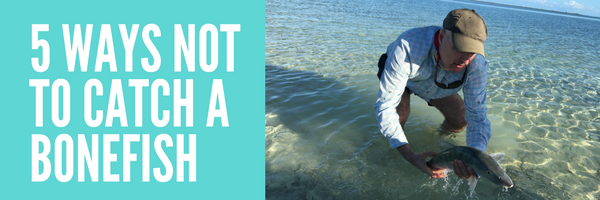Bonefish are smart, savvy and prone to run. When you see big bones out on the flats, you should know that they’ve likely reached their impressive size due to their innate ability to both sense and flee from danger. This makes stealth, skill and practice incredibly important. Following are five rookie mistakes that will keep you from ever hauling any big bones in.
1. Wearing Your Wading Shoes While In The Boat
When it comes to catching bonefish, being stealthy is about far more than landing your fly in the right place at the right time. You also have to be mindful of the sounds you’re making, the scent you’re giving off and the colors that you’re wearing. Stomping around on the boat bottom in a pair of heavy wading boots is bound to end in frustration. Going barefoot is always going to be your best bet. Just don’t forget to put plenty of sunscreen on the tops of your feet. More importantly, bare feet will give you a much better ability to determine whether or not you’re standing on your fly line.
2. Using A Fly That’s Too Heavy For The Water You’re Fishing In
Keep your lead-eye flies at home. Bonefish are usually found in shallow water and thus, anything too big or too heavy is virtually guaranteed to spook them. If this is your first time out, be mindful of the fact that much of your fishing will be done at depths of just ten inches. Also, when fishing in water less than 12 inches deep, bear in mind that you won’t have to weight your fly. Unweighted flies are going to land a lot softer and thus, they’ll be a lot less likely to attract the wrong sort of attention.
3. Only Looking At The Fish You’re Targeting
Be mindful of the fact that bonefish are almost always traveling together. As such, even if you can only spot a single bone through the water’s glare, there’s probably several more in the area. If you line any of the fish that you don’t see, all of them will spook and swim off. Before casting, pause for a second and carefully assess the area to find the perfect point for landing your fly.
4. Casting Too Far
Over-casting when bonefishing is virtually guaranteed to result in a wasted opportunity. With bonefishing, you’re basically walking a delicate line between capturing the attention of your target and not scaring the fish off. Cast too far and you’ll wind up lining the bones, rather than hauling him in. Casting in front of bones, however, increases the likelihood of your having an actively feeding fish swim right up for a nibble.
5. Not Paying Attention To Your Stripped Off Line
Never get so caught up in what you’re doing that your forget to manage your stripped off line. This should always be in a neat pile on the boat bottom or on the deck. If you go out wading, keep it nicely looped behind you. If your line gets under the boat or trapped on your fishing companion’s gear, problems will ensue.
Fishing for bones is challenging enough without your making these common, rookie mistakes. Be mindful of your line, keep your feet bare and make sure that you aren’t overcasting. With the right fly and a willingness to pay attention to your guide, you’re bound to bring an impressive bone in.









